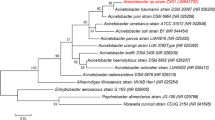Abstract
Bacterium djl-6, capable of degrading carbendazim, was isolated by continuous enrichment culture originating from carbendazim-treated soil. The isolate was identified as Rhodococcus sp. according to its phenotypic features, physiologic and biochemical characteristics, and phylogenetic analysis. The strain could use carbendazim as sole carbon or nitrogen source. It showed a high average degradation rate of 55.56 mg · L−1 · d−1 in M9 medium amended with carbendazim. High-pressure liquid chromatography–mass spectrometry (HPLC-MS) analysis showed the presence of 2-aminobenzimidazole, benzimidazole, and an unknown metabolite with molecular ions (M+) of m/z 104.8 and 118.5. The degradation in the isolate djl-6 seems to be initiated with the cleavage of the methyl carbemate side chain, resulting in the formation of 2-aminobenzimidazole and benzimidazole. This is the first report of the intermediates benzimidazole and 2-aminobenzimidazole found together in the culture filtrate of pure bacterium.





Similar content being viewed by others
Literature Cited
Bell KS, Philp JC, Aw DWJ, Christofi N (1998) The genus Rhodococcus. J Appl Microbiol 85:195–210
Euzeby JP (2006) List of prokaryotic names with standing in nomenclature—Genus Rhodococcus. Available at: http://www.bacterio.cict.fr/index.html. Accessed: February 10, 2006
Fuchs A, FWD Vries (1978) Bacterial breakdown of benomyl I. Pure cultures. Antonie van Leeuwenhoek 44:283–292
Helweg A (1972) Microbial breakdown of the fungicide benomyl. Soil Biol Biochem 4:377–378
Holt JG, Krieg NR, Sneath PHA, Staley JT, Williams ST (eds) (1994). Bergey’s manual of determinative bacteriology. 9th ed. Baltimore, MD, Lippincott Williams and Wilkins, pp 626–640
Holtman MA, Kobayashi DY (1997) Identification of Rhodococcus erythropolis isolates capable of degrading the fungicide carbendazim. Appl Microbiol Biotechnol 47:578–582
Kiigemagi U, Inman RD, Mellenthin WM, Deinzer ML (1991) Residues of benomyl (determined as carbendazim) and captan in postharvest pears in cold storage. J Agric Food Chem 39:400–403
Matsumura F, Murti CRK (eds) (1982) Biodegradation of pesticides. New York, NY, Plenum, pp 147–151
Mazellier P, Leroy E, Laat JT, Legube B (2003) Degradation of carbendazim by UV/H2O2 investigated by kinetic modeling. Environ Chem Lett 1:68–72
Pattanasupong A, Nagase H, Sugimoto E, Hori Y, Hirata K, Tani K, et al. (2004) Degradation of carbendazim and 2,4-dichlorphenoxyacetic acid by immobilized consortium on loofa sponge. J Biosci Bioeng 98:28–33
Sambrook J, Fritsch EF, Maniatis T (eds) (1989) Molecular cloning: A laboratory manual. 2nd ed, vols. 1-3. Cold Spring Harbor, NY, Cold Spring Harbor Laboratory
Sarrif AM, Arce GT, Krahn GF, O’Neil RM, Reynolds VL (1994) Evaluation of carbendazim for gene mutations in the salmonella/Ames plate-incorporation assay: The role of aminophenazine impurities. Mutat Res 321:43–56
Shao ZQ, Seffens W, Mulbry W, Behki RM (1995) Cloning and expression of the s-triazine hydrolase gene(trzA) from Rhodococcus corallinus and development of Rhodococcus recombinant strains capable of dealkylating and dechlorinating the herbicide atrazine. J Bacteriol 177:5748–5755
World Health Organization (1993) Environment health criteria 149: Carbendazim. Available at: http://www.inchem.org/documents/ehc/ehc/ehc149.htm. Accessed: October 11, 2005
Zhang GS, Jia XM, Cheng TF, Ma XH, Zhao YH (2005) Isolation and characterization of a new carbendazim-degrading Ralstonia sp. Strain. World J Microbiol Biotechnol 21:265–269
Acknowledgments
This work was supported by the Chinese National Programs for High Technology Research and Development (Nos. 2003AA241150, 2004AA206071, and 2004AA214102) and the Programs for Science and Technology Development of Jiangsu Province (Nos. BE2002345 and BE2003343).
Author information
Authors and Affiliations
Corresponding author
Rights and permissions
About this article
Cite this article
Jing-Liang, X., Xiang-Yang, G., Biao, S. et al. Isolation and Characterization of a Carbendazim-Degrading Rhodococcus sp. djl-6. Curr Microbiol 53, 72–76 (2006). https://doi.org/10.1007/s00284-005-0474-3
Received:
Accepted:
Published:
Issue Date:
DOI: https://doi.org/10.1007/s00284-005-0474-3




